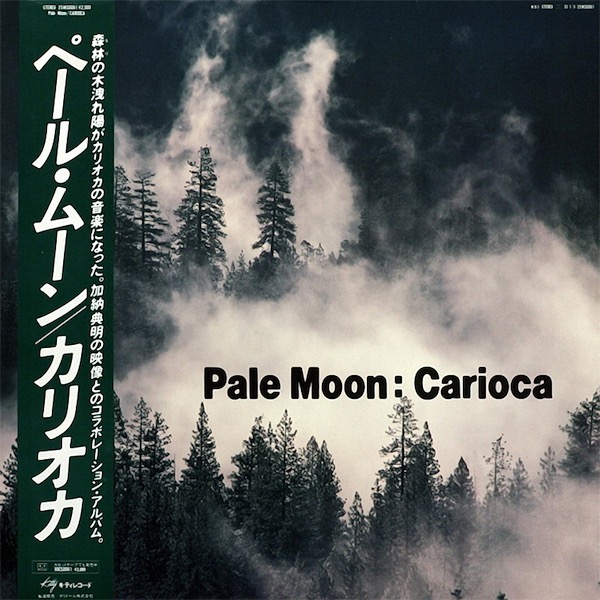
Who knows where the time goes? Because, apparently, lately it’s me. Through some fated collusion of circumstance and consequence, both personal and external, I’ve spent most of my day tied to a phone, tied to things out of my control. With the holidays – at least in America – upon us, what precious moments I do have, my headspace (at least, the musical one) goes back to album’s like Carioca’s Pale Moon. Gentle, breezy, moody, and sophisticated, it’s Japanese jazz of an easy listen, uncategorizable but in my favorite universal way. Quite simply: it’s background music to deep thoughts caught in the linger of fleeting moments.

There once was a band of young Japanese jazz students who were pieced together into a band by Japan’s Jose Feliciano, blind folk-rocker Kiyoshi Hasegawa, to back up his exploration of Latin jazz and Brazilian music. At the “Loft” in Shinjuku, they started a “Sunday Samba Session” where a revolving group of forward-thinking musicians like Masami Satoh, Tetsuya Hayakawa, Ryuichi Sakamoto, Pecker, and Yuichi “Antonio” Ishida (to name precious few) reinterpreted the classic samba and bossa nova songs brought from the Japanese-Brazilian diaspora into the homegrown Japanese idiom.
When Kiyoshi decided to head creatively elsewhere, his backup band (now led by pianist Hiroki Inui, flutist Nozomu Nakatani, and guitarist Masami Satoh) decided to strike out on their own as “Samba Carioca”. They’d release records like 1978’s Sunny Place Carnival and 1979’s Little Train Carioca combining deep Brazilian cuts with originals inspired by that far-flung cultural touchpoint. In quick succession, they’d drop the ‘Samba’ from the name, almost as if accepting their ascension as one of Japan’s up-and-coming premier jazz-funk groups. They’d also treat themselves as more of a scene where individual members could come and go, to explore all sorts of fusion jazz.
Carioca, of course, would always be first and foremost easy listening. Promoted heavily under the guise of fusion jazz, future albums like 1983’s Dusk and 1981’s Snooze slotted effortlessly on anyone’s “out on the catamaran” marine radio station. All of this makes my favorite release of theirs, surprisingly, standout.

You see, 1984’s Pale Moon marked a tonal sea change. In 1983, they were presented with an opportunity: create music for an atmospheric Laserdisc video. On Horizon Dream, much like fellow co-compatriots Masayoshi Takanaka and “Mimi” Kobayashi, songs like “Honey Moon” skirted so many new, unique lines that predicted future scenes of a certain vaporous quality. Not quite BGM, muzak, healing music, new age or ambient, this “resort music” is distinctly less sunny, slower and more meditative. Cognizant of who’d buy such media – such ideas were built as A/V mood pieces.
Pale Moon is a gorgeous soundtrack-of-sort to images that would be of less sunny locales. Working with photographer Tenmei Kanoh, they were tasked to create music that fit more wintry environs of California’s Yosemite National Park. Far from the beach, it was our American forests, canyons, and mountainscapes that had to be adorned with “Carioca”-style music that met such places where they were emotionally.
That’s why you’d hear Masami Satoh write perhaps his most elegiac and wistful music yet. Songs like “Niño” and “Aliento Verde” have a certain saudade that was noticeably absent (or as pronounced) in earlier music. Hiroki Inui’s cuts like “Deep Into The Night” and “I Love Highland” have a sterling, almost Lyle Mays-like quality, lyrical tracks that explore or luxuriate in slow tempos, probing “mystical” moods for a certain vibe.
Hearing Geraldo Vespar’s proto-bossanova “Chuva” transformed into something its own, bit ethereal remains, still, impressive. Weirdly enough, the final track “Floatin’” hints on tiny melodies gleaned from (I firmly believe) the The Lovin’ Spoonful’s “Rain On The Roof” and ends the album just as it started – quiet, big time ruminations on bits of far-off landscapes, captured in memories more suited for personal viewing. I mean, before every sunny day there must be a moon to pass your hopes, dreams, and (yes) sorrows and pains, through.
